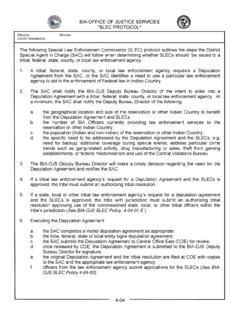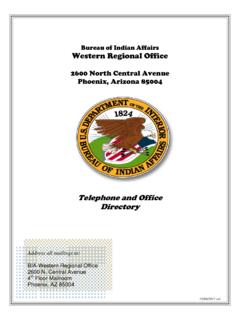Transcription of Exclusion of Indigenous Language Speaking …
1 Exclusion of Indigenous Language Speaking Immigrants (ILSI). In the US Immigration System, a technical review. Exclusion of Indigenous Language Speaking Immigrants in the US immigration System, a technical review 1. Exclusion of Indigenous Language Speaking Immigrants (ILSI). In the US Immigration System, a technical review. Preface Quey coq ncoyolna tuj Kyo'l. Wey quin nchin xolan tuj. Indigenous peoples, like all peoples, need to communicate in their primary Language in order to respond to human communications. Over eighty Indigenous languages represent the daily communication patterns of Indigenous immigrants from Mexico and Central America. Many of those Indigenous Language speakers enter the United States and travel in its interior. Most Indigenous Language speakers from Mexico and Central America do not read nor write in the written from of their Language - which for many Indigenous languages is a relatively new development.
2 If you did not understand the first six words written in this preface, you might have experienced what many Indigenous Language Speaking immigrants in the US immigration system experience - Language Exclusion . That Language happens to be from the largest group of Indigenous Language Speaking immigrants from Guatemalan entering the United States Maya Mam. From the perspective of the Indigenous Language speaker, it is not only contact with US immigration officials authorized to conduct interrogations and interviews for legal purposes that requires interpretation of their primary Language , it is also contact with other key governmental and privately contracted personnel who make decisions about their welfare while in transit, in detention, and under federal custody that necessitates that their interactions be conducted in their primary Language .
3 In that vein, this technical review was prepared in conjunction with the Declaration of the Rights of Indigenous Language Speaking Immigrants. The technical review was prepared by Ama Consultants for the originators of the Declaration, the Guatemalan Community in Tucson, Arizona, United States. Translation: We speak Mam. I speak Mam. 2. Exclusion of Indigenous Language Speaking Immigrants (ILSI). In the US Immigration System, a technical review. Indigenous Language Speaking Immigrants (ILSI) in the US Immigration System, a technical review. 26 May, 2015. Prepared by Blake Gentry for Ama Consultants Contents Preface 2. Glossary and Acknowledgements 4. I. Federal Limited English Proficient (LEP) Policy in US immigration 6. I. LEP Practice in US Immigration System 10. III. ILSI Perspectives on Language Exclusion in the US Immigration System 21.
4 ILSI Families in Short Term Detention 22. ILSI Individuals in Detention 26. ILSI Individuals in Streamline Criminal Court 34. Unaccompanied ILSI Children 38. IV. Conclusion: Legal Myopia about Indigenous Language Rights 46. V. Recommendations for Effective LEP Programs for Indigenous 51. Language Speaking Immigrants. VI. Appendix A: ILSI Language Exclusion in the US Immigration System 56. Endnotes 58. _____. ILSI Language Exclusion Diagrams: Language Exclusion Contacts for ILSI Families 23. Language Exclusion Contacts for ILSIs in Immigration Court 27. Language Exclusion Contacts for ILSIs in Streamline Court 32. Language Exclusion Contacts for Unaccompanied ILSI Children 43. All Rights Reserved 2015. Publisher: Ama Consultants 3. Exclusion of Indigenous Language Speaking Immigrants (ILSI). In the US Immigration System, a technical review.
5 Acknowledgements: One hundred and thirty-six Acateco, Chuj, Kanjobal, Kachiquel, K'iche, Mam, Mixtec, Tohono O'odham, Popti, Poqomchi, and other unidentified Indigenous Language Speaking immigrants - whose stories and photos are contained herein; Dr. David Charles Wright (Universidad de Guanajuato, Mex.), Member of the Committee of Experts and the Scientific Follow- Up Committee of the Universal Declaration of Linguistic Rights (Barcelona, 1996); Fernand de Varennes, Dean Faculty of Law, Universit de Moncton (Canada) and Extraordinary Professor, Faculty of Law, University of Pretoria (South Africa);. Elisabeth Santpere for research on Indigenous family immigration; Maria Rebeca Cartes for Spanish Language translation, Anonymous contributors: four attorneys of non-profit immigration services (two in Arizona, two in Texas), attorney in private practice, Pro bono attorney; two observers of conditions in shelters for unaccompanied children, Laurie Melrood LMSW, program administrators of legal orientation programs for adults and unaccompanied children, two observers of Streamline Operations; and a human rights analyst, and for the cover page photo montage, John Eisner.
6 Glossary of Terms ILSI ( Indigenous Language Speaking immigrant ) family, individual, or unaccompanied child. DHS (Department of Homeland Security) Sub-Agencies: CBP (Customs Border Patrol). BP Station (Border Patrol Station). BPSPC (Border Patrol Service Processing Center). FOB (Forward Operating Base). POE (Port of Entry). ICE (Immigration and Customs Enforcement). ERO (ICE Office of Enforcement and Removal Operations). ERO (Enforcement and Removal Officer). Family Detention Center (FDC). LLE (Local Law Enforcement PEP Partners). PEP/SCP (Priority Enforcement Program/ formerly Secure Communities Program). USCIS (United States Citizenship and Immigration Services). AO (Asylum Officer). (DHHS) Department of Health and Human Services ORR (Office of refugee Resettlement). DOJ (Department of Justice). AG (Attorney General). BIA (Bureau of immigration Appeals EOIR (Office of Immigration Review).)
7 IJ (Immigration Judge). NTA (Notice to Appear). OCC (Office of Chief Council). USAO (United States Attorney Office). 4. Exclusion of Indigenous Language Speaking Immigrants (ILSI). In the US Immigration System, a technical review. Purpose This technical review examines Indigenous Language Speaking immigrants (ILSIs) and Federal Limited English Proficiency (LEP) policy by reviewing LEP policy and practice within the US immigration system, by demonstrating the points of Language Exclusion contact for Indigenous Language Speaking individuals, families, and unaccompanied children, and by making recommendations for effective Language inclusion of Indigenous Language Speaking immigrants. The size of the Indigenous Language Speaking migrant population affected by immigration enforcement and legal proceedings remains unknown largely due to their persistent Exclusion as a racial class and the Exclusion of their languages.
8 The operational scope of federal LEP policy appears superficially applied in an irregular program by semi-autonomous federal immigration agencies. Though the origin of federal LEP policy lies in the Executive Office, federal departments' programmatic formulation of the LEP policy initiative has been weak. Therefore, in addition to the main tasks, this review specifically examines both the undefined nature of that gap in policy, and the resulting gap in practice. Methods Quantitative estimations of immigrant Language populations were based on a sample of immigrant families. Estimations based on that proxy may approximate but not represent unassessed Indigenous Language populations. Qualitatively, this technical review examined LEP policy documents from the Executive, Departments of Justice (DOJ), Homeland Security (DHS), Health and Human Services (DHHS), and State.
9 Limited English Proficiency Program (LEP) Guidance issued by those Departments and related agency documents of the Department of Homeland Security's Office of the Inspector General, Customs and Border Patrol, Immigration and Customs Enforcement, DOJ's Executive Office for Immigration Review and Office of Chief Judge, DHHS's Office of Refugee Resettlement, and the General Accounting Office. Sources consulted on Language Exclusion and LEP issues in the immigration system were from the Women's Refugee Commission and Lutheran Immigration Services, Language Access Advocates Network, Guatemala Acupuncture and Medical Aid Project, Florence immigrant and Refugee Rights Project, NYU Chapter of the NLG, Migration Policy institute, ACLU, the White House blog, and media sources. Issues of LEP practice and Language rights in international conventions were from the Vera Institute, the Institute for Social and Economic Development, UN Special Rapporteurs Rodolfo Stavenhagen and James Anaya, UN ICCPR, UN.
10 DRIP, UNHCR, Enabling Legislation (Homeland Security Act of 2002), Civil Rights Act (Title VI) and published public comments on DHS's LEP policy in the Federal Register. Service provider and immigration court sources consulted were from the Vera Institute, Florence Refugee and immigrant Rights Project, the United States Sentencing Commission, and the Institute for the Study of International Migration, Georgetown University. Interviews were conducted in person, via phone and e-mail were conducted with private, Pro bono, and non-profit attorneys in Texas and Arizona; with an ORR spokesperson, a Streamline court interpreter, former UAC and family shelter workers and volunteers, volunteers visiting three detention centers, and immigrants released on bond, paroled, and with expedited removal orders. Two Language specialists were consulted regarding Language ideology, history, policy, and issues of dialect.

